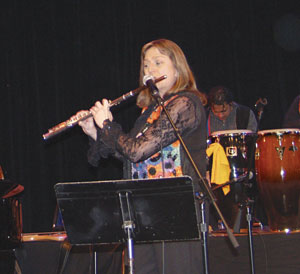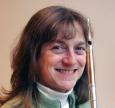Flutist Cynthia Folio composed Arca Sacra for the National Flute Association’s 1997 High School Soloist competition. The title of the work is a palindrome, which is a word, phrase, or number that reads the same backward or forward. Applied to music, it indicates “pieces which repeat the same events backward after a midpoint.”1
Because Arca Sacra does not use measures, line numbers will be used as references. The work is in a ternary arch form as shown in the table below.
Section Line Numbers
A 1-8
B 9-29
A’ 30-34
Folio told me that the title “reflects the shape of the piece and also describes its palindromic ABA form. One of my graduate students tells me the title means sacred ark in Spanish.”
The following comments were made by Folio during a lesson I took with her on Arca Sacra in La Jolla, California in 2005. Therefore, all musical directions in the following section are her thoughts.
Line 1:
The opening line includes pitch bending, which creates a Native American flute sound. I also had the Japanese shakuhachi, North Indian bansuri, and jazz in mind. These instruments all come together for me. Try to bend the pitches as much as possible, as in Native American music, particularly on the D to F in Line 1. I finger D normally at first and then add the left-hand first finger while sliding the right-hand fingers off the holes.

You don’t even have to finger the F. Slide the fingers all the way off the holes, keeping the key rings down during the slide. That keeps the pitch from getting too high. If you let the keys up, you will produce a different note. Robert Dick has an entire chapter on how to slide in The Other Flute: A Performance Manual of Contemporary Techniques. He discusses how to do a continuous slide for the entire length of the flute.2
Line 2:
There is another bend or slide on the B flat in the middle of Line 2. For this one you could also exaggerate the slide by depressing the A key without covering the hole as you bend the pitch lower. Adding the half-hole very gradually during the bend drops the pitch down to A flat. If you are uncomfortable adding a half-hole, just try to bend more.
Be careful not to sock the A after the crescendo/decrescendo at the end of line 2. This can occur because it is a low note. Make sure that you emphasize the diminuendo. All of the Ds in Line 2 should be D#s.
Line 3:
There is a bend from A flat to E at the end of Line 3. After the bend down, come back up fast to the E while sliding right-hand fingers 1 and 2 onto the keys for the E. Make the rising tuplet a six-note tuplet, rather than a five-note tuplet, by including the rest in the 16th-note figure.

Lines 4-7:
The sixth note in the line should be an A flat. At the end of the line, roll the flute in on the high F to make it flat; then roll out on the F harmonic at the beginning of line 5. The challenge is to have those two Fs in tune with each other. On the flourish in the middle of line 6, bring out the B flat. It should pop out of the texture because it is the center note in the palindrome. Be careful, as the B flat can easily get lost because it is a fast passage. The last note of the line is a G#, as is the first note of Line 7.

Lines 8-10:
At the very end of section A, prepare the new tempo in Line 9 by thinking in 16ths by the end of Line 8. Breathing is a challenge here, but the poco rallentando in Line 7 allows time for a breath. Then breathe before the beginning of 8 and try to make it through the first measure in Line 10 before breathing again. The accelerando in Line 8 should help.
I recommend single tonguing in the B section because it is clearer. Gauge the speed of the eighths in 8 to be similar to the 16ths in 9 by accelerating on each note. A great dynamic contrast between the two measures in line 9 will add interest. The second measure of 9 should be much softer than the first, almost like a whisper with some mystery. You also save air that way. The crescendo in line 10 is important, so make more out of it.
Lines 11-15:
The standard fingering from low E to C# requires the right-hand pinky down on both pitches, but omit the pinky here, as in the trill fingering. Diminuendo more on the second measure of Line 11 to a mp dynamic to give the piece more shape. Articulate accents well in general, but particularly when they create groups of threes, such as those at the end of Line 13.
The whisper in Line 16 should be mostly air. You may want to anticipate that airyness by making the accents in Line 15 kind of airy. Pretend that you are a beginner who can’t quite find the embouchure hole. Blow but don’t focus the air and keep it very soft.
Lines 16-26:
This is the line with the octatonic scale. Line 17 should also be airy, and Line 18 should be marked whisper (but more sound). Normally, flutists aim the air across the embouchure hole to produce a wonderful sound, but here try aiming the air up a little higher. It doesn’t feel like a different embouchure to me; it is more of an aim. Where is that hole?
Start to focus a little in 19 and be clearly focused by the beginning of Line 20. Some musical directions were omitted in the first printing, but a second edition is available now. Please write in m.o. (modo ordinario indicates a return to a normal sound) in the first bar of Line 19, almost normal sound in the 1/4 bar that follows, and m.o. in the 3/8 bar. The punctuated eighths in this section should be resonant, accented, but not long.

Lines 27-34:
The flutter tongue in Line 27 should start on the G# and end on high B. Add an accent over the high C# two notes later as well. Try the tongue flutter with some vocalization to get the R to roll.
This fluttered arpeggio explodes on the high C-C#, and after that, things start to wind down. The palindromes begin to break down in Line 28, and the passage loses momentum by the time the A section returns in Line 30. Finally you land on a low D in Line 30 – back to where you started. That is the sensation that I am looking for – sort of a winding down, almost kind of breaking down. It is a transition back to the lyrical A section.
I have argued with myself about where to breathe in Lines 29-30. I don’t want to breathe before 30, but there doesn’t seem to be any way around it. Ideally, it would be best to go from the end of 29 to the end of 30 without a breath. My preference is to have all of Line 30 one breath. For the low E-Aflat slide at the end of Line 31, slide left-hand second and third fingers and right-hand first and second fingers off the keys simultaneously. There is no need to actually finger the A flat. Just use your ear until you hear anA flat and then slowly let it go.
The term niente (disappearing to nothing) works well at the end of lines 31, 32, and 33. Drag the slide out on the half-note B flat in 33, slowly disappearing at the same time. Close the A-key ring with the left-hand second finger but don’t cover the hole. Note that all the Ds in line 33 should be D#s.
For the slide on Line 34, slide the right-hand first and second fingers off the holes, leaving the keys down, and slide them independently of each other. Experiment with moving the second finger first, followed by the first finger until you get a slide that is smooth and even. I like the effect of sliding and disappearing at the same time, but it does take some practice to arrive on the correct note!
At the end of the lesson, Folio said, “While I hope that flutists appreciate the structure of the work (the scales and palindromes), I also hope they find it expressive and fun to play. The style reflects many musical idioms that are part of my experience, especially ethnic music and jazz.”
***
A clear understanding and analysis of Arca Sacra only enhances its effectiveness. The conclusion of this guide addresses the various scales and palindromes found within.
Palindromes By Line Number
In addition to the overall structure of the work, many of the lines in the piece include palindromic phrases. The following list includes every motive that is a palindrome.
Line 1: Opening motive
Line 2: Motive beginning with B-flat 16th notes
Motive beginning on A grace note
Line 3: Motive beginning with the 16th-note run on C
Line 6: Motive beginning on low A
Motive beginning on low G#
Lines 16 and 17: the whisper section is a palindrome of groupings: 2 + 3 + 4 + 6 + 4 + 3 + 2; each group has the same notes. At first the groups are articulated by rests, but this switches to slurs in line 16.
Line 17: First five notes and last five 16ths of 2nd bar
Line 22: Second measure from the second high G to the last high G; F# is the midpoint.
Line 23: Second note of second measure through end of third measure with the B flat; B natural is the middle of palindrome.
Line 24: From first five 16ths through last five 16ths (groups, not pitches).
Line 28: Last four 16ths of the second measure.
Last measure (B, G#, G, E followed by E, G, G#, B in diminution).
Line 30: A palindrome of intervals.
Line 32: Second C through the next C
Line 33: First motive
Beginning on the second D#
Line 34: Final motive of piece
From line 27 on, only fragments of symmetrical scales or note groups are used.
Augmented Scales
Arca Sacra uses complete and fragmented forms of augmented scales throughout. Examples can be found in lines 7-13. Augmented scales are inversionally symmetrical, and therefore palindromes of intervals. Other examples are lines 3 and 4 (C, E flat, E, G, A flat, B) and line 29. Of course, the main motive in the high register (line 19 after the airy tone) is mostly minor thirds and half steps. The last six notes of line 8 are an ascending augmented scale, and line 9 has descending augmented scales in diminution.
Because most classically-trained flutists don’t practice augmented or octatonic scales, adding them to your practice routine is a good idea. Folio urges, “Contemporary music is filled with octatonic and augmented scales–especially the former. Whole- tone scales are important to practice too, because the French flute repertoire uses them so much. All of these symmetric scales are also great for use in jazz improvisation! I practice them almost daily.” (see “Symmetrical Scales in French Flute Repertoire” on page 21 for more information and practice ideas.)
Complete octatonic scales are not used in Arca Sacra, but seven of the eight notes are in the whisper section in line 16: C #, D, E, F, G, A flat, B flat.
Accent and Polyrhythms
Line 15: There is an accent on every fifth note starting on the E in the second measure. The accents create a polyrhythm. Folio states, “My intent was to establish a new pulse for a couple of bars to create instability; each accent should be felt as a larger beat, slower than the quarter =108, more like quarter = 86”.
Line 22: The first measure has accents on every fourth note, again intended to create a new pulse, this time faster than quarter = 108, more like
quarter = 144.
Section A Gestures That Return
Lines 1 & 34: The final gesture is a restatement of the opening one, an octave lower and inverted.
The next to last gesture is the same as the first four notes of the second one, an octave lower and inverted.
Lines 2 & 34: Both quarter-note triplets are a tritone plus a perfect fourth.
The timbral trill in Line 2 repeats in Line 34 an octave lower and starts fast and gets slower, the opposite of the opening timbral trill.
The beginning of Line 2 until the timbral trill is inverted at the beginning of Line 34.
Lines 2 & 33: The quarter-note triplet through the bend on the B flat is inverted in Line 33. The pitches are the same in both gestures.
The first gesture of Line 33 is an inversion of the last gesture of Line 2.
Lines 3 & 32: The first gesture of Line 3 is the last one of Line 32, but the dynamics are reversed. The only notes that are not palindromic in 3 and 32 are the grace note D to B.
Lines 3 & 31: The last three notes of Line 3 are an exact retrograde in Line 31: A flat, E, G becomes G, E, A flat with a slide between the same two notes.
Lines 5 & 31: There are harmonics in both lines, although not strictly repeated or in a palindrome.
Line 30: This line presents a different kind of palindrome from some of the others listed above. From beginning to end it is a palindrome of intervals and rhythms rather than exact pitches. The minor third up from low D to F at the beginning of the line is matched by a minor third down from D flat to B flat moving backwards (retrograde) from the end of the line. Follow all the intervals forward and backwards in this way to arrive at a midpoint of E flat and C (the two eighths). Note that the rhythms go backwards as well. The line begins and ends with a dotted half note, which is followed and preceded by an eighth-note triplet, etc. This line is also based on intervals from the augmented scale.
1 Paul Griffiths, The Thames and Hudson Encyclopaedia of 20th-Century Music (New York: Thames and Hudson Inc., 1986, reprint, 1992), 134.
2 Robert Dick, The Other Flute: A Performance Manual of Contemporary Techniques, 2d ed. (St. Louis, MO: Multiple Breath Music Company, 1989), 76.
Flutist and composer Cynthia Folio earned a bachelor’s degree in flute performance at West Chester University in Pennsylvania, where she studied flute with Emily Swartley-Newbold and composition and electronic music with Larry Nelson. Following graduation she went to the Eastman School of Music, where she earned master’s and doctoral degrees in music theory working with Joseph Schwanter, Robert Morris, and Alexander R. Brinkman. She also received a performer’s certificate in flute with Bonita Boyd.
After a ten-year position at Texas Christian University, she became a music theory professor at Temple University, where she still teaches. Besides the 1997 Arca Sacra’s premiere at the N.F.A. convention, she has had other works performed at N.F.A. conventions, including her Trio (1994) for flute, cello, and piano, which won the N.F.A. Newly Published Music Competition and The Elements (1986) for flute choir. Her chamber music CD, Flute Loops, was released in 2006.
Folio writes in various styles including multimedia works, compositions that include improvisation, folk and jazz inspired pieces, and spatial works for larger ensembles. As a theorist, composer, and performer, her main interests include analysis and performance of contemporary music, analysis of jazz, and the relationship between analysis and performance. Her webpage is http://astro.temple.edu/~cfolio.





